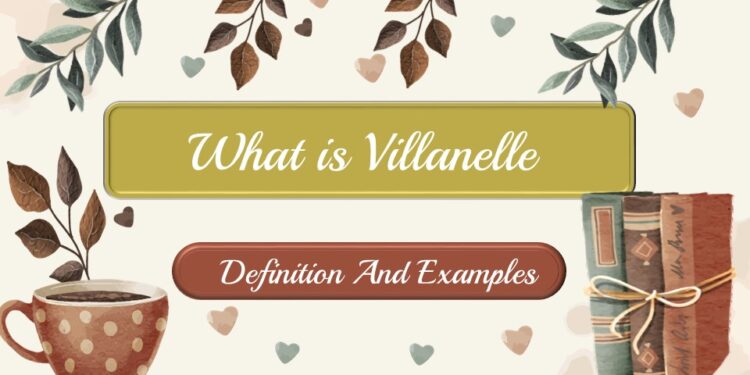What is Villanelle Definition And Examples
A villanelle is a poetic form consisting of 19 lines with a specific rhyming and repetitive structure. It is known for its distinctive pattern of repeated lines and refrains, creating a musical and lyrical quality.
Also Read-
- What is Tone Definition And Examples
- What is Theme Definition And Examples
- What is Syntax Definition And Examples
The villanelle originated in France during the Renaissance and gained popularity in English literature through poets like Dylan Thomas and Elizabeth Bishop.
Characteristics of a Villanelle:
- Repetition: The villanelle relies heavily on repetition, with the two refrains appearing multiple times throughout the poem. What is Villanelle Definition And Examples This repetition creates a musical quality and emphasizes certain ideas or emotions.
- Syllable and Line Length: There are no specific requirements for syllable or line length in a villanelle. What is Villanelle Definition And Examples Poets have the freedom to choose the desired meter and line length based on the overall aesthetic and flow of the poem.
- Exploration of Themes: Villanelles often explore themes of love, loss, memory, and introspection. The repetitive structure can lend itself well to capturing the cyclical nature of these themes or the obsessive thoughts and emotions associated with them.
- Imagery and Symbolism: Villanelles often employ vivid imagery and symbolic language to evoke emotions and convey deeper meanings. What is Villanelle Definition And Examples The limited number of lines encourages poets to be concise and impactful in their word choice.
Examples of Villanelles:
- “Do not go gentle into that good night” by Dylan Thomas: Do not go gentle into that good night, Old age should burn and rave at close of day; Rage, rage against the dying of the light.Though wise men at their end know dark is right, Because their words had forked no lightning they Do not go gentle into that good night.
Good men, the last wave by, crying how bright Their frail deeds might have danced in a green bay, Rage, rage against the dying of the light.
Wild men who caught and sang the sun in flight, And learn, too late, they grieved it on its way, Do not go gentle into that good night.
Grave men, near death, who see with blinding sight Blind eyes could blaze like meteors and be gay, Rage, rage against the dying of the light.
And you, my father, there on the sad height, Curse, bless, me now with your fierce tears, I pray. Do not go gentle into that good night. Rage, rage against the dying of the light.
- “One Art” by Elizabeth Bishop: The art of losing isn’t hard to master; so many things seem filled with the intent to be lost that their loss is no disaster.Lose something every day. Accept the fluster of lost door keys, the hour badly spent. The art of losing isn’t hard to master.
Then practice losing farther, losing faster: places, and names, and where it was you meant to travel. None of these will bring disaster.
I lost my mother’s watch. And look! my last, or next-to-last, of three loved houses went. The art of losing isn’t hard to master.
I lost two cities, lovely ones. And, vaster, some realms I owned, two rivers, a continent. I miss them, but it wasn’t a disaster.
–Even losing you (the joking voice, a gesture I love) I shan’t have lied. It’s evident the art of losing’s not too hard to master though it may look like (Write it!) like disaster.
Conclusion
A villanelle is a poetic form that combines a specific structure of repeated lines and refrains with vivid imagery and exploration of themes. What is Villanelle Definition And Examples With its rhythmic and melodic qualities, the villanelle creates a unique and captivating experience for both the poet and the reader. What is Villanelle Definition And Examples Through the skillful use of repetition, rhyme, and word choice, poets can convey deep emotions, explore complex ideas, and evoke powerful imagery within the limited confines of the form. What is Villanelle Definition And Examples The examples provided by Dylan Thomas and Elizabeth Bishop showcase the beauty and versatility of the villanelle, highlighting its ability to convey profound thoughts and evoke strong emotions.
FAQ.
Q. Can the villanelle be used to explore themes other than those mentioned?
Ans. Absolutely! While themes of love, loss, memory, and introspection are commonly associated with the villanelle, poets have the freedom to explore any theme they desire. The form’s repetitive structure and emotional resonance can lend themselves well to a wide range of subjects and ideas.
Q. Can the order of the refrains be altered in a villanelle?
Ans. Traditionally, the order of the refrains in a villanelle remains consistent throughout the poem. The first refrain is used as the last line of the second and fourth tercets and as the final line of the quatrain. The second refrain is used as the final line of the third and fifth tercets and as the penultimate line of the quatrain. This repetition contributes to the musical and structural integrity of the form.
Q. Are there variations or adaptations of the villanelle form?
Ans. While the traditional villanelle structure remains the most common, there have been variations and adaptations of the form over time. Some poets have experimented with altering the line and stanza lengths, or deviating from the strict ABA rhyme scheme. These variations allow for creative flexibility while still retaining some of the core elements of the villanelle.
Q. Can the villanelle be challenging to write?
Ans. Writing a villanelle can be challenging due to the strict structure and repetition requirements. Poets must carefully consider the placement and repetition of the refrains while maintaining coherence and flow in their overall message. However, this challenge also presents an opportunity for creativity and ingenuity, as poets find innovative ways to express their thoughts within the confines of the form.
Q. Can the villanelle be used in contemporary poetry?
Ans. Yes, the villanelle continues to be utilized by contemporary poets. Many poets appreciate the formal constraints of the villanelle as a means of honing their craft and exploring their creativity. It offers a structured framework within which they can experiment and engage with their chosen themes in a unique and compelling manner.
















